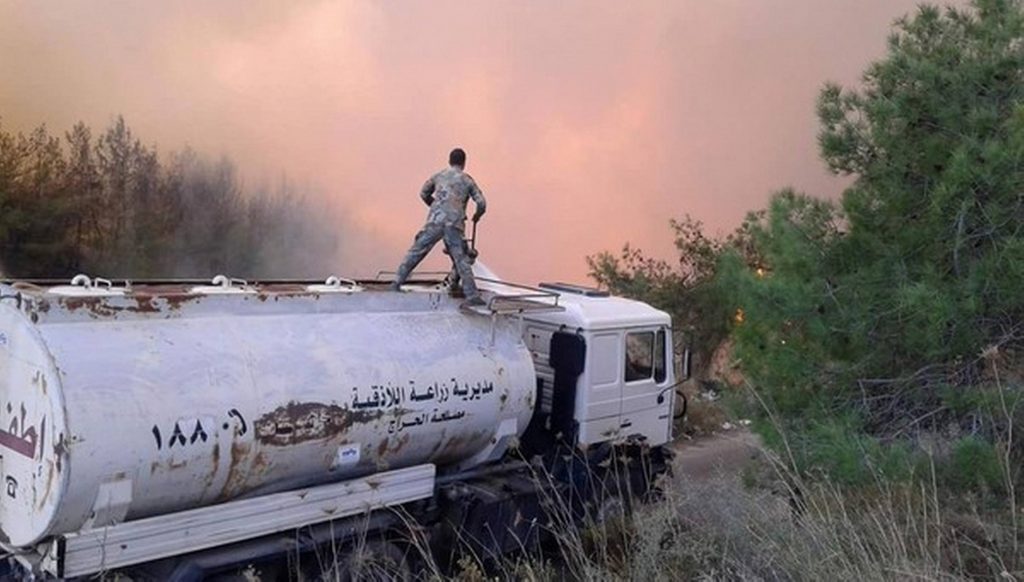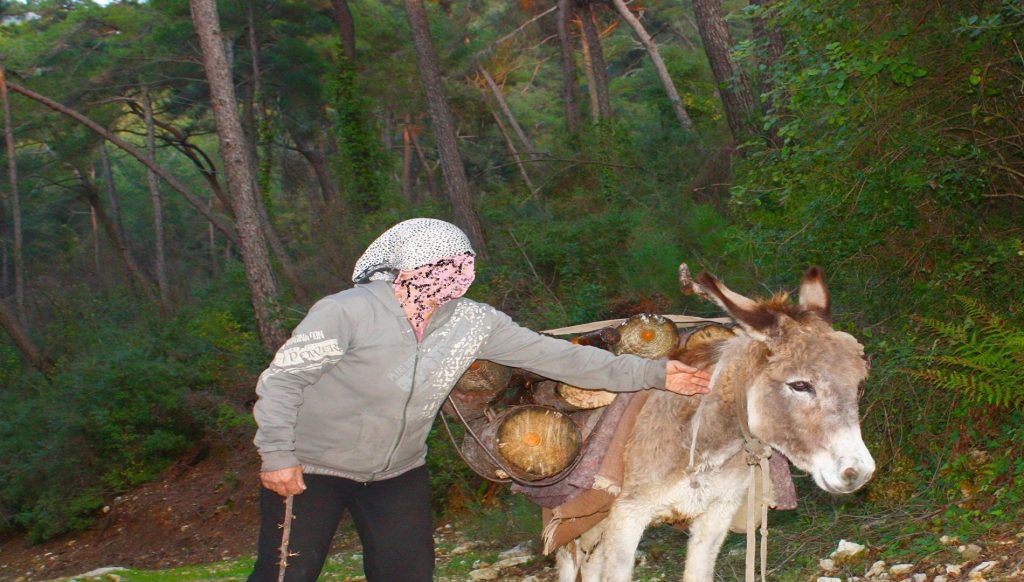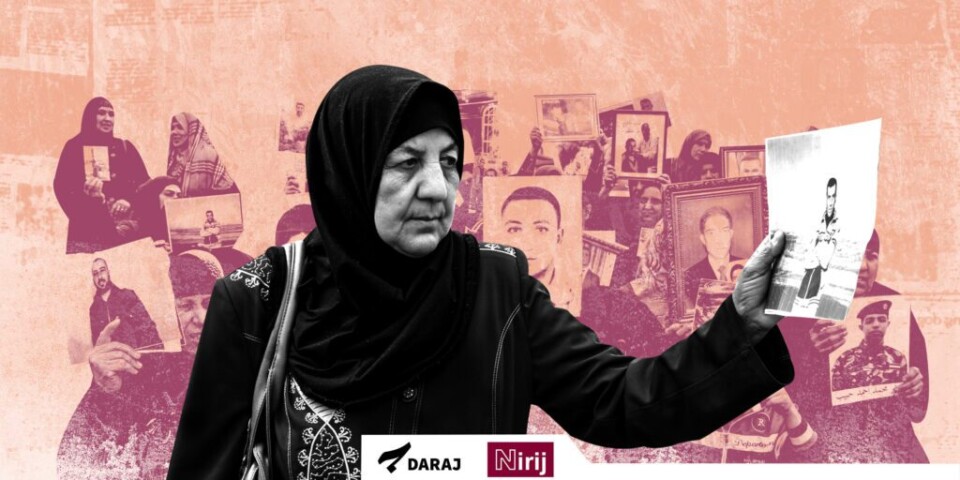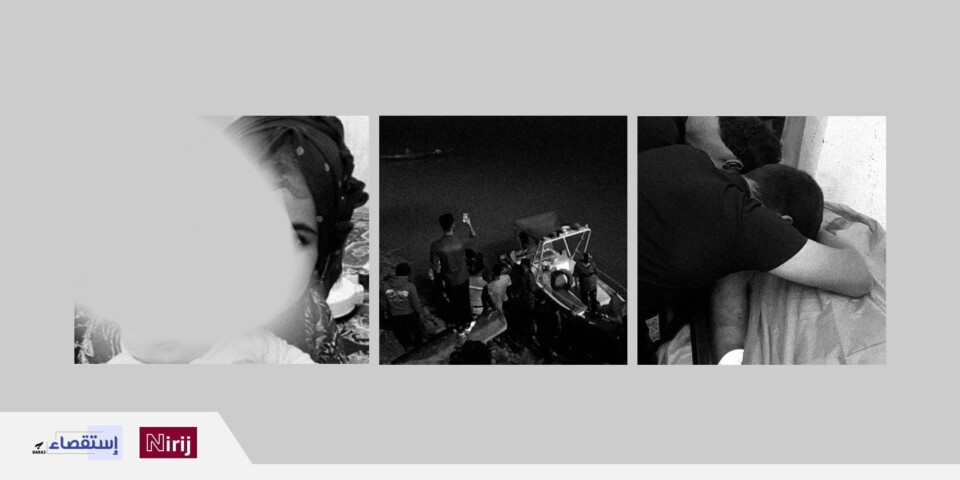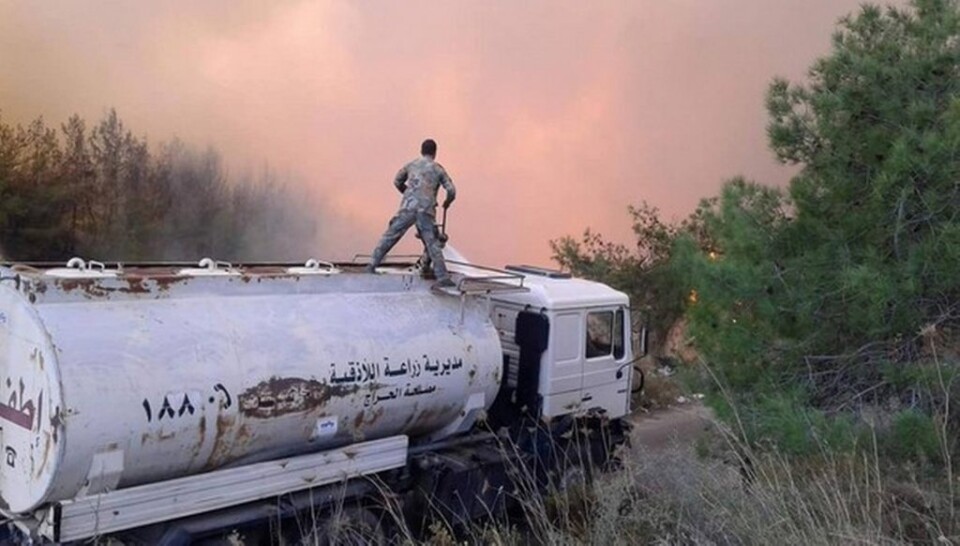

Kamal Shahin ,Syrian journalist and writer.
On Nov. 3, 2016, shortly before the rain season began, Ibrahim al-Boudi (pseudonym) had just finished cleaning up his land planted with olive trees, and he left to his nearby village Bkailoun to sleep early as usual. Bkailoun administratively is part of the Qardaha District in Latakia Governorate on the Syrian coast.
Around 2 a.m., he woke up startled to the sound of noise and screams and was feeling short of breath. At first, he thought he was having a stroke, but the screams coming from the neighborhood made him rush out of the house, and he saw what he would never have wished to see.
Scene 1
That day, 15 fires broke out in the mountains of Latakia countryside a few hours after sunset. The worst was in the neighborhood of Ibrahim’s village in Jabal al-Arbaeen in Al-Qardahah (45 km from Latakia), and it destroyed 100 hectares out of its 35,000 hectares of green space, including natural trees (oak, carob, etc…) and others planted through artificial forestation (pine). This was the worst incident affecting a local popular touristic site since decades, and the fire spread to the houses of civilians.
It was strange that the fires broke out on the same day, as “most trees in these sites are broad-leaved, and fires are less likely among them compared to pine forests,” according to Lattakia’s Agriculture Directorate and the European Forest Fire Information System.
Bassel, 37-year-old a firefighter who helped in extinguishing the fire said that “such fires are highly controllable, despite difficulties posed by the elevations of the forests and the weak fire trails.”
He continued, “however, their outbreak on the same day made it impossible to extinguish them at the same time.”
The fires broke out in different coastal areas. These areas are so vast that some are separated by hundreds of kilometers and are not easily reachable. Latakia’s limited firefighting capacities made it hard to reach all the areas affected by the fire, although the firefighters requested engines from neighboring provinces also. For more than a week, the fire swept through hundreds of hectares of trees (more than 400 hectares), and smoke engulfed the whole area. People suffered from shortness of breath in coastal cities that were relatively far from the fire, and some firefighters were injured.
A fire in Jabal al-Arbaeen in Al-Qardahah, 2016. Copyrights: Agriculture and Forestry Directorate in Latakia. The photos are published under fair use.
Scene 2
More than two years after this incident, the 70-year-old Ibrahim walks around his land, searching for a green bud that still has not appeared. He whispers with a sad voice, “The fire burned my face several times, and I almost died. It is no use talking about it now. May God never forgive the culprits.” When we asked him about the party responsible in his opinion, he shook his head and left.
Collective attack on forests?
Ibrahim’s son Munzer, 26-year-old who is an agricultural engineer, told us when we spoke to him in the village that “fires have been ongoing since the great fire (as the 2016 fire was called). In November 2018, a fire broke out near Al-Mahaliba Castle, and it spread to Jabal al-Arbaeen, as dry eastern winds were blowing, which made the fire spread faster. But, the firefighting team controlled it before reaching civilians’ houses, although it had already scorched 15 hectares of agricultural lands planted with olive trees.”
So far, 75 forest fires have broken out in Al-Qardahah alone over more than 40 hectares. Due to these fires, more than 90% of the plant cover of this area has been destroyed.
Most fires were caused by human factors (whether deliberate or non-deliberate, like burning agricultural waste, producing coal and burning forest outputs such as pruning). The percentage of coastal fires increased from 41% between 1987 and 1998 to more than 90% between 2011 and 2018, according to Yakzan Maarouf, an engineer from Tishrin University, Faculty of Agriculture.
Text in the figure Above:
Most fires were caused by human factors.
The percentage of fires 41% between 1987 and 1998 , and 90% between 2011 and 2018.
According to a report published by Latakia’s Agriculture Directorate, fires are still on the rise and scorched more than a quarter of the surface area of forests in the country during the war years between 2010 and 2018. More than 2000 officially registered fires were reported, covering 103,000 hectares of burnt land. The coast suffered more than 800 fires of the registered ones, some of which resulted from military operations (like in Al-Basit areas that lost more than 13,000 hectares in 2013).
Text in the figure above:
fires consumed more than a quarter of the surface area of forests in the country during the war years between 2010 and 2018. More than 2000 fires were reported, the coast suffered more than 800 fires
In Tartous, 1300 fires of different kinds (including forest fires covering less than 25 hectares) were registered in 2016, and 851 fires in 2017, mainly the Dahr al-Anaza (Al-Mshayrfe) fire that scorched 20 hectares of Turkish pine and the fire in Majdaloun al-Boustane in Safita. In the areas of the eastern slopes of the coastal mountain range, a fire hit Masyaf city end of 2017 and destroyed what was left of its forest that was the area’s only green space and its lung. The citizens’ protests before official institutions to arrest specific people whom they accused of starting the fire fell on deaf ears.
Masyaf fire in 2017. Copyright: Masyaf page on Facebook. Published under fair use.
In recent years, logging forests became more popular, as they were considered the easiest, safest and least costly source of income, compared to agriculture. Due to the lack of job opportunities, the value of the local currency dropped ten-fold and the ongoing fuel crisis as a result of international sanctions on Syria and armed groups’ seizure of energy sites in the eastern part of the country, the price of fuel used for heating soared ten-fold.
Copyright: EFFIS. The chart is published under fair use
Mohammad Husseino is 42-year-old and works at the Tobacco Company (Regis), he hails from Beshlama village in Al-Qardahah countryside. He said that he cuts and gathers wood from the nearby forest on his days off from morning to evening, and he sells part of the logs and uses others for heating in his cold town. He monthly income is $50, after having served the state for 20 years, and this salary can barely cover his kids’ transportation fees to university.
The increasing logging activity increased the risk of fire outbreaks, according to agricultural engineer Layal. She is 26- year-old and works at Tartous’ Agriculture Directorate. “A lot of the trees are highly flammable pine trees because they contain resin oils that burn quickly. Besides, the wind carries the scattering peel of burned tree trunks and pine cones far, which spreads the fire more rapidly.” she said
Jalal is a 28-years-old doctor and activist working with an environmental organization in Tartous. He said, “The leaves and branches of the pine trees’ trunk that are closest to the soil are often dry and are considered primary fuel for any fire as they burn quickly and intensely. For that reason, the Agriculture and Forestry Directorate trims them and removes them yearly.”
In addition to the particular nature of the forest, farmers who live nearby blaze their lands to clear dry grass during critical seasons like the olive-picking season (October and November), which is the driest season in Syria.
Balzing the land to get rid of agriculture waste caused a fire in Al-Anaza in Baniyas countryside. Photo taken in 2015. copyrights: SyriaUntold
Hassan Ali, a 52- year-old farmer who hails from Al-Zouba in Tartous said, “Last year, I set agricultural waste on fire in my land, and part of the nearby forest burned with it.” He then called firefighters who came to the rescue.
Are militias above the law?
Charcoaling, logging and cutting trees provide good income, compared to other available work during the war. Producing one kilogram of charcoaling wood costs 50 Syrian Pounds (4 cents), while one kilogram of coal is sold for 300-500 SYP ($0.6-$1) in the charcoaling kiln. In markets in the coastal area, the price reaches 1200 SYP ($2.5), while in Damascus it exceeds 1500 SYP ($3). Hassan, 32- year-old who owns a licensed charcoaling kiln in Al-Anaza in Baniyas countryside, told us during a meeting in his village, “We are facing strong competition from people who carry out illegitimate charcoaling and logging in broad daylight. But no one can stop them, as their weapons are always ready.”
A photo of a woman while logging in a forest. We covered her face to protect her identity. Copyright: SyriaUntold
Hassan added, “since they do not have much experience in this field, there is a high risk they might cause fires.”
In February, we visited a charcoaling kiln in Beit Yashout (40 km from Jableh), where a fire broke out in the forests of Bsheili village and destroyed 10 dunams of pine and cedars in November 2018 – the same month the 2016 fires happened. These kilns might have been responsible for the fire, according to local sources.
An Illegal charcoaling kiln in Beit Yashout, February 2019. Copyright: SyriaUntold
In a phone call with a person close to the kiln owners, we learnt that there were three people in the kiln, and one of them was carrying a Kalashnikov. They were wearing military coats with the logo of the Suqour al-Sahra militia established by the famous businessman Ayman Jaber in 2015. Most members of the militia hail from the coastal regions and still have military and civil influence in the area despite the militia’s dissolution.
Ahmed (pseudonym), a 26- year-old former fighter who was injured in the war, he has an impaired left arm. He said, “we need three days to finish the processing procedure. Then, we transfer the products on bikes to a certain place, and the muallem’s [chief] men take them.”
A charcol warehouse, Jablah. March 2019. Copyright: SyriaUntold.
These men are what remains of a generation that the Syrian war drained then threw to the dogs, after pro-government militias were disbanded in 2017, based on a Russian decision. However, they remain influential, especially as some the militia members hide behind justifications of sacrifices they offered during the war. Until today, the security situation remains tense between these unofficial forces and other state institutions. Some militias are still operational in some areas, especially since their role did not end completely in some compact regions or in their own region. Still, many of the militias were disbanded and annexed to other major military regiments like the 5th Corps.
Ahmed who participated in the battles alongside the Suqour militia for three years in Palmyra in the middle of the country said, “We sacrificed ourselves so that others could live. We have the right to live too. If it weren’t for us, all Syria would have been scorched. I do not hold a degree or have a profession. I had no option. The militia administration did not give me a dime in compensation. Above it all, I have to do compulsory military service once again. I have to work to feed my three small children. God protect our muallem.”
The word muallem is used without mentioning the name. However, he is present and he deters any attempt to come close to the unlicensed kiln. The muallem is usually a military officer who occupied or still occupies an important rank. Nobody can stop him or his men, and all measures against them fail and cannot put an end to their activity, as the muallem remains well-connected to governmental circles, through bribery or threats.
Any interaction with the muallem for people outside his circle is out of the question, and nobody can discuss his activity in any way, otherwise, they would have to suffer the consequences. Imagine if that person is a journalist!
One of those muallems is a former chief of a security branch and still has connections. He seized a forest in Qurfays mountain area, and everyone knows him by the name. The members of the forest control unit look to please him so that he does not hurt them and transfer them to remote areas. As a result, charcoaling, cutting trees and forest abuse continue undeterred.
Yassin is a 35- years-old and works in Qurfays forests said during a meeting in person, “A sum of money that reaches 100,000 SYP per year ($200) should be paid to the muallem’s agent. If there is any delay in the payment, the concerned person is forbidden from doing any activity in the nearby forests.”
Meanwhile, the majority of security or official bodies turn a blind eye to the presence and activities of these groups allowing them to destroy entire forests in the areas of Baniyas countryside, al-Hafah, Qardahah and elsewhere.
Mohammed A., who has been working in logging, and is from Dardara village in Baniyas countryside said during an interview with him, “Everyone knows what militia members do in the woods and valleys of the area. Their role is not limited to charring. In light of the fuel price increase and fears of its recurrent shortage, the price of the ton of firewood has increased from about 15,000 SYP [$30] to 80,000-90,000 SYP($180-$200) this year. Militia members can deliver firewood to any place through a network of agents dispatched across all [Syrian] areas.”
Charcoal kilns endanger the forest, as the charcoaling technical requirements are not met. Such processes can easily ignite fires, especially when workers leave the site. However, charcoal workers are keen on preserving the forest and do not deliberately want to burn it. Activist Hazem Hassan (pseudonym), 41-year-old employee and head of an environmental association in the coast area, asserts that charcoal workers have no interest in destroying their source of livelihood, from which they can benefit for many years to come. “Any burnt land is marked by a fire mention on its real estate register. Only those who have connections that allow them to remove this mention are able to afford to start large fires.”
Long gone are the glory days of forest guards!
An old forest guard, who is 50-year-old man from the village of Bustan al-Soj in Dreikish countryside, has spent almost thirty years in service. He told us, on condition of anonymity for security necessities, that last March during his patrol in the forest near the village, he heard the sound of an automatic saw and breaking trees. He tried to document the incident using his mobile phone to film how he would confiscate the saw and bring its user to the police station. But, the man with the saw pulled his gun threatening to kill him if he came any closer. “I had to leave the place, as the man was serious, not to mention that he is well-connected.”
The old guard was threatened several times for informing the official authorities of a number of violations. He ended up asking for his transfer to another position unrelated to forests. “In the past, a forest guard enjoyed authority,” he said, “today he’s not worth a penny.”
Most probably, this incident was not the only one. Forest guards have the authority to prevent transgressions on forests, grasslands and any green vegetation, including logging within private properties. They may also bring transgressors to the nearest police station by force of arm.
Across the Syrian territories, the plant cover is state-owned in accordance with the law governing forests. Most recently, the 2018 Law No. 6 was issued on the regulation and investment of forest areas, but to this date, it is not implemented.
The forest guard went on, “A National Defense member, even if released from service, can bring any guard to his knees even if he had fifty years of service, in light of the power and influence of the various armed forces de facto present in these areas.”
The forest control unit operates based on an infrastructure mainly consisting of control towers. Only 10 out of 38 towers remain standing, and are supposed to cover more than 230,000 hectares in Latakia. The situation in Tartous is similar, although no battles took place in the city. In light of the imposed economic sanctions, wireless devices used by guards have been damaged and remained unrepaired. Very few pieces are still functioning.
Forest Observation Tower, Beit Yashout. February 2019. Copyright: SyriaUntold
The guard pointed out that he would have confiscated the transgressors’ tools and identity papers and draft an official report of the violation and hand it over to the Forestry Department, which transmits the report to the competent authorities (Civil Police and Criminal Security) to investigate the matter and then refer the person concerned to justice. This is still the followed procedure now. Last year, according to the Agriculture Directorate and the Forestry Department in Tartous more than 669 different violation reports were drafted, on transgressions such as logging, charcoaling, selling, transferring and land seizures. However, in Latakia, only 20 violation reports were referred to the courts according to a lawyer from the city.
The fate of these reports varies depending on the persons involved. Usually, some “small” transgressors end up bearing the balme so that the official bodies appear fulfilling their duty. But if we consider that 90% of the forest violations are recorded against an “unknown person,” we understand the scale of the problem. And the question remains: who is this unknown?
Fires break out when ustazes invest
Until 1994, bulldozers swept dozens of hectares of forest trees in the nearby mountain peaks. The scene was familiar to many residents of Ain al-Baida, Salnafa, Qardahah and others, who were unable to raise any objection.
Everyone knew that these bulldozers were for the ustazes (plural of ustaz, Arabic for master), who are known by name, and who do not even pay for fuel. They would always bring these bulldozers with their drivers from the IFAD agricultural development project, according to a 39-year-old driver called Ayman from Nabeh al-Khandak village (administratively follows the town of Basta). “This has always been the case,” he said. “Today they are exploiting these territories and no one can stop them.”
For Anwar, a 52-year-old lawyer from Latakia, these lands were planted with long-living fruit trees that are over 15 years old, such as olive trees. These fully grown trees were dug up and brought in from other places to be planted here. He explained, “A claim of ownership would be instigated before courts on the grounds that the concerned property is a private property that has not registered with the real estate register before. To prove ownership they would cite as evidence the old age of the trees. By colluding with the concerned committees, the property would become private ownership.” This is what happened in several areas, where properties are mostly state-owned because of the higher percentage of forests (65%).
In 1994, aerial photography of the Syrian territory was carried out, and forest and grassland areas were carefully demarcated. Anwar pointed out that transgression on state-owned forest lands was no longer possible, theoretically at least , and the acquisition scenario was no longer valid. He said, “This prompted attempts to invest these lands by burning their trees. In accordance with Article 14-b of the law on forests, a fire mention is noted on the real estate register of burnt lands, and it is prohibited to remove this mention under Law No. 6/2018, which also requires reforesting such lands. This closed the door to any real estate investment in these forests and maintained the possibility of economically exploiting them”
Whenever a fire was put out anywhere on the Syrian coast, traders from outside the area would soon flock to gather burnt and unburned trees, transporting them to unknown locations. Local residents were denied any access to the burnt areas and were not allowed to use even one branch. [While filming, we were denied access to some of the burnt areas in Jabal Al-Arbaeen.] The guards in a military uniform always justified this ban, saying, “The ustaz is paying and is investing the forest.”
The ustaz is similar to these muallems but of a higher standing since he is a civilian, not a military person. He would never get personally involved in any of these businesses since he has agents doing the work on his behalf.
In November 2018, the governor of Lattakia asked the police station in Janjania in the eastern Latakia countryside to dispatch a patrol to raid a coal and wood warehouse in an area surrounding the village. After a heated quarrel with the patrol headed by the chief of Ain al-Baida police station (an officer from Hama whose name was kept confidential for security reasons), the warehouse owners who work under the protection of ustaz (H.A.) physically assaulted the patrol members and detained the district manager, who accompanied the patrol, for hours. The ustaz ended up intervening personally, through a telephone call, for his release. Later on, the district manager was transferred to another post.
A villager told us this incident on condition of anonymity for fear of clashing with the ustaz’s men..
Another ustaz also known by name, sent his men to cut long-living trees dating back to the Crusader era in the Cedar and Fir Natural Reserve. In other areas, ustazes have more limited control and influence. In Tartous, muallem still cut down forests despite all of the measures taken by the concerned authorities.
Taking all of this into consideration, it is only natural to believe the doubts raised by the locals in the area that these ustazes and muallems are deliberately setting up fires to destroy small branches and keep tree trunks. This would make it easier for them to exploit these [burnt] trees through official auctions launched by the Agriculture Directorates to be able to “legally” exploit the trees in burnt lands. They would get their way at any price.
Conclusion:
According to inside information from the Agriculture Directorate in Latakia, Ustaz B.A. collected all proceeds from the burnt trees in Jabal al-Arbaeen (estimated at tens of thousands) that were officially logged by commission of the Agriculture Directorate after the fire.
It was not possible to verify the legality of the awarding of the contract relying on the usual usual method of inspecting tenders. Companies hide behind unknown denominations and are established for the purpose of participating in these tenders to prevent any unknown bidders from winning.
If any bidders enter these tenders, they would be forced out in various ways, such as being given a sum of money to guarantee that they would not offer a lower price in the tender. In the previous tender, eight companies offered their bids, and they are believed to be affiliated with the same ustaz.
Translated by: Pascale Menassa
This investigation is published in partnership with Nirij, and was supervised by Koumai Almelhem.
Investigative Reports
Investigative Reports","field":"name"}],"number":"1","meta_query":[[]],"paged":1,"original_offset":0,"object_ids":21735}" data-page="1" data-max-pages="1">

